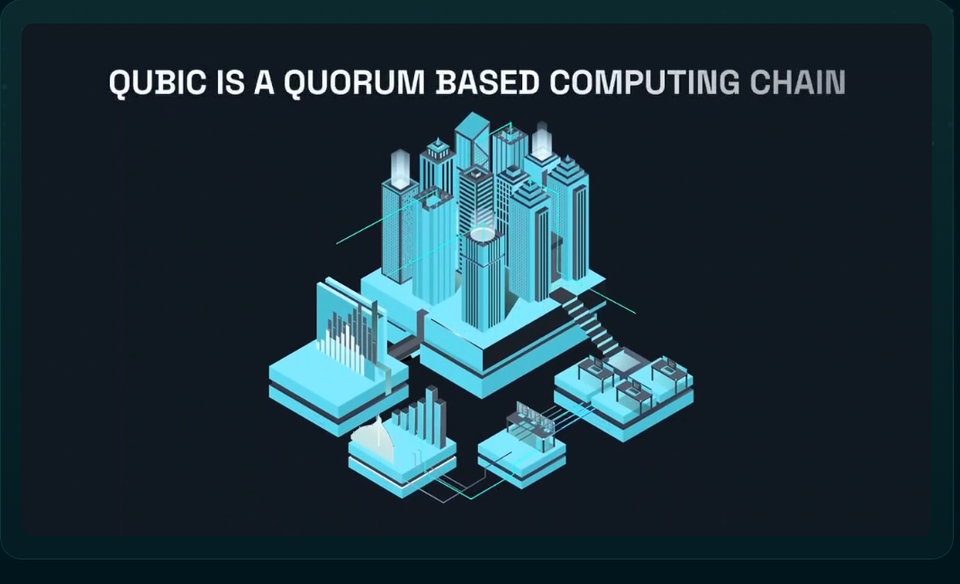Crypto Guide: What is QUBIC?

Decentralized Web 3.0 networks are growing constantly, with new technology and upgrades benefitting developers, users, and the general community. This industry has spawned several memorable projects, but one project is slowly gaining traction: Qubic. Qubic is an open-source and community-driven project founded by Sergey Ivancheglo. Its whitepaper describes Qubic as the future of decentralized AI-Layer 1 blockchain. But what does it mean to be an AI and Layer 1 blockchain, and what makes it different from other Web 3.0 projects?
Qubic is an open-source and community-driven project started by Sergey Ivancheglo, the same person behind the full PoS & DAG protocol (NXT & IOTA). Although the Qubic project was first conceptualized in 2012, it has only been in recent months that it has been making a buzz with its technology and performance.
According to multiple reports, the Qubic platform has hit an incredible 40 million transactions per second (TPS). In contrast, Solana and Ethereum boast 2,397 and 246, respectively. While many still debate the value of using TPS as the sole indicator of stability, it remains an essential yardstick in the industry. Qubic's performance beats out other platforms with lightning-fast transactions, like Solana, BSC, and Polygon, making it an attractive platform for users and developers.
Qubic and 'useful Proof-of-Work' (UPoW)
One way to understand a blockchain project is to examine its consensus mechanism. Qubic relies on a slightly modified version of the Proof-of-Work (PoW) consensus employed by popular projects, including Bitcoin and Dogecoin. Through the PoW mechanism, altering or creating fraudulent transactions becomes time-consuming and computationally expensive. However, this mechanism uses huge computational power, which drains resources. Qubic addresses this using a 'useful Proof-of-Work' (UPoW) by integrating AI training to achieve consensus.
Qubic's approach pushes the boundaries of traditional PoW by integrating AI training tasks to achieve consensus. The protocol boasts Computors (validators) that work with miners to use AI models to solve training tasks instead of traditional mathematical puzzles. The network feeds AI models with complex training tasks, like processing large data sets. This mechanism ensures that Computors' work will also have real-world applications.
A look at Qubic's tokenomics
$QUBIC is the network's utility coin that acts as an in-platform currency and an 'energy unit'. The $QUBIC fuels executing smart contracts and enjoying the community's other services. These coins are burned after use (and removed from circulation), making Qubic's tokenomics unique. Also, $QUBIC is the computational 'energy' spent on the platform.
The Qubic network produces 1 trillion $QUBIC every seven days, called an 'epoch.' These tokens are primarily distributed to Computers, the network's main driver. The circulating coins are capped at 200 trillion, which the community has voted upon.
Also, the community follows an emission schedule to manage the supply. For the first year, the reduction is a maximum of 15% in emissions. Afterwards, emissions will be halved annually. These policies, capping supply and halving emissions yearly, are designed to boost the ecosystem and attract more users and entrepreneurs.
How about Qubic's smart contracts?
One key component in every Web 3.0 platform is the smart contract. Unlike other blockchains, Qubic's policies on smart contracts are a bit different. Each proposed smart contract must pass a Quorum proposal vote, ensuring that only legitimate smart contracts operate on the platform. Once a contract has passed the voting, it is then launched via an IPO with 676 shares.
The native tokens spent on these shares are locked in the contract, which is paid for executing the contract and also helps reduce the number of tokens in circulation. Shareholders (or those who participated in the contract's IPO) get passive income from the contract fees.
According to its white paper, the contract is self-sustaining until the locked tokens are used. For reference, Qubic shared that the three smart contracts on the platform burned over 10.50 trillion $QUBIC.
What are Computors and Arbitrators?
In most Proof- of-Work (PoW) blockchains, miners play a crucial role in managing the blockchain, particularly in adding and verifying new blocks. In Qubic, the miners play a secondary role as Computors and Arbitrators. The Computors are the primary actors in maintaining the platform's economic balance. Computors perform the tasks assigned by the Arbitrator and they vote by Quorum to determine the commission to be charged for executing smart contracts. However,
Computors don't get tokens as commissions as these are 'burned'. There are 676 Computors or Validators, and through their vote of over two-thirds (451+), they ensure the finality and reliability of transactions.
Then, there are the Arbitrators, who assign AI training tasks but don't participate in voting and smart contract execution. However, Arbitrators can also help in dispute resolution or when addressing challenges within the network. In short, they help maintain the overall stability of the Qubic ecosystem. The segregation of roles within the community sustains and promotes Qubic's decentralization feature.
Advantages of Qubic over other Web 3.0 platforms

There are several advantages to using the Qubic platform and its native token, the $QUBIC:
Fast transfers with no fees
Qubic is a Layer 1 blockchain that doesn't charge for value transfers. Since transactions are feeless, the Qubic platform is more efficient and user-friendly. Also, the fees for executing contracts don't go directly to individuals since these are burned, reinforcing that its token is a form of energy, not money.
Useful proof-of-work (UPoW) is more energy-efficient
Qubic relies on the 'useful PoW' as a consensus mechanism, which is more energy-efficient. Instead of spending huge energy resources to solve complex problems, Qubic redirects these to training in Artificial Neural Networks (ANNs), thus helping promote the development of machine learning. Mining remains an integral process within the platform. Still, it's not primarily to validate transactions and add new blocks but as a mechanism to establish the Computors' rankings for each epoch.
In the Qubic community, the higher one's ranking, the bigger the potential for earnings. This distribution model aims to encourage efficiency, and there's a dip in potential revenue if the Computor performs at a sub-optimal level.
Fully decentralized
Qubic supports decentralization through its unique approach to governance. In a decentralized platform, no single entity or organization controls the management and policy-making within the community. At Qubic, there is a separation of power between the Quorum (a pool that's made up of Computors) and the Arbitrators. The Quorum is a group of two-thirds or at least 451 Computors of the community that participates in decision-making. For example, the Quorum maintains consensus, validates transactions with finality, and votes on smart contracts. The
Arbitrators, on the other hand, are the ones that set the parameters for the mining algorithm, publish the list of Computors for every epoch, and decide to remove under-performing Computors. Also, the Arbitrator also decide on disputes and resolving the issues in the community.
To ensure that there's no collusion, the Arbitrators get the remaining revenues after the Computors have collected their rewards, which roughly translates to 1% per epoch.
How to invest in Qubic?
Individuals interested in investing and supporting Qubic can do so by buying the tokens from crypto exchanges.
Currently, Cubic's native coin is available in at least 12 crypto exchanges. Regardless of where you purchased your coins, you still need to set up your Qubic wallet to store these coins. To create your Qubic wallet, you must create a seed, a 55-character lowercase string that acts as your password.
Then, you'll need to get your Qubic ID. Your ID is a 60-character string sourced from your seed. You can now use the qubic.org wallet to manage your native tokens. You can create a vault and add the seed to interact with the community.
In addition to an online wallet, highly recommended hardware wallets can be used to store and trade your tokens. Again, we recommend practicing due diligence and researching before buying tokens or investing in new projects like Qubic.

